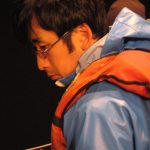Toru Kobari
Effects of turbulent nutrients flux on plankton community structure and productivity in the Kuroshio
Research Summary
The Kuroshio has been thought to be low biological productivity due to the oligotrophic conditions and low standing stocks of plankton community. Contrary to this general view, the Kuroshio in the East China Sea (ECS-Kuroshio) is well known as a major spawning and nursery grounds for various forage fishes. These findings raise the question why many forage fishes spend vulnerable early life stages under the oligotrophic and low primary production environments around the ECS-Kuroshio (i.e., risky strategy for food availability of fish larvae). This is known as the Kuroshio Paradox.
Recent studies after 2000 demonstrated that physical oceanographic features like passing through continental slope and archipelago were quite specific to the ECS-Kuroshio compared with those in the Gulf Stream. In particular, turbulent mixing and island mass effect in the Tokara Strait are likely strong compared with the previous measurements at offshore sites. While these physical processes would expect to stimulate plankton productivity in the downstream of the Kuroshio, we have no information on field data analyses and experimental evaluations.
In this study, we would like to evaluate the effects of turbulent nutrients flux on plankton community structure and productivity. To achieve this final goal, we will clarify the following issues.
Subject 1: Range of turbulent nitrate flux in the Tokara Strait
We determine the range of turbulent nitrate flux in the Kuroshio by measuring turbulent mixing and in situ nitrate concentrations during the Lagrange oceanographic observations from the upstream to downstream of the Kuroshio around the Tokara Strait.
Subject 2: Field evaluation of the effects of turbulent nitrate flux on plankton community
We explore the spatial changes in taxonomic composition, biomass and productivity of plankton community from upstream to downstream of the Kuroshio by oceanographic observations and sample collections.
Subject 3: Experimental evaluation of the effects of turbulent nitrate flux on plankton community
We evaluate the effects of turbulent nutrients flux on plankton biomass and productivity by onboard bottle incubations with nutrients enrichments at different concentrations including the range of the turbulent nitrate flux measured in the Tokara Strait.
If the effects of turbulent nutrients flux on plankton community structure and productivity in the Tokara Strait are clarified through the present study, our results would be a breakthrough to solve the Kuroshio Paradox because turbulent nutrients flux stimulate biological productivity at lower trophic levels of the Kuroshio ecosystems and thus provide good food availability for fish larvae. Also, these results might make a paradigm shift of the Kuroshio from “desert in ocean” to “nursery in ocean”.
Principal Investigator:
- Toru Kobari (Ph.D.)
Aquatic Sciences, Faculty of Fisheries, Kagoshima University Associate Professor
http://www.fish.kagoshima-u.ac.jp/aqua/
Collaborators:Hirohiko Nakamura Aquatic Sciences, Faculty of Fisheries, Kagoshima University
Collaborators:Daisuke Hasegawa Fisheries Oceanography and Resources Department, Tohoku National Fisheries Research Institute, Japan Fisheries Research and Education Agency
Collaborators:Takeyoshi Nagai School of Marine Resources and Environment, Tokyo University of Marine Science and Technology
Collaborators:Naoki Yoshie Division of Environmental Dynamics, Center for Marine Environmental Studies, Ehime University


